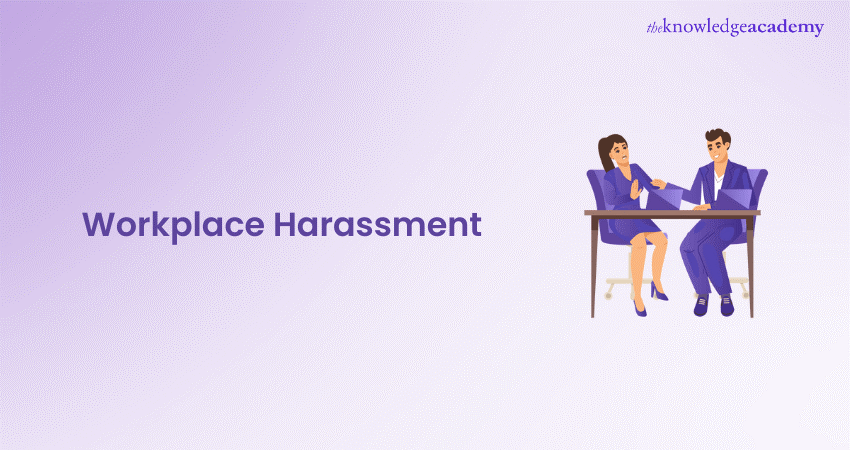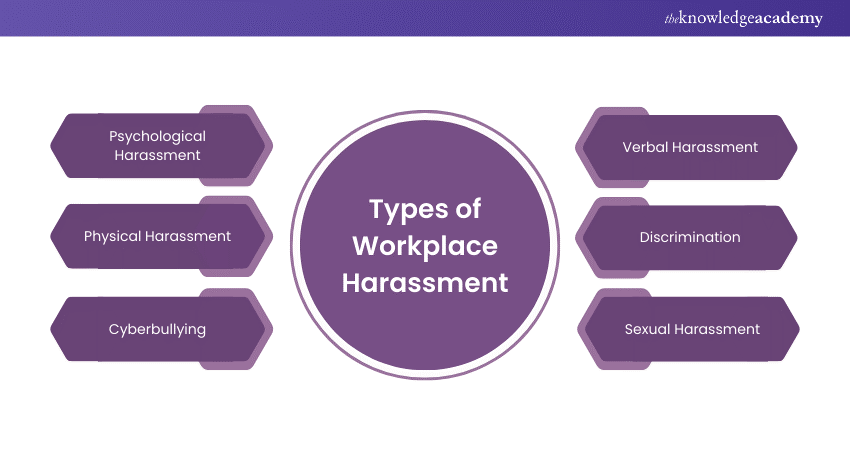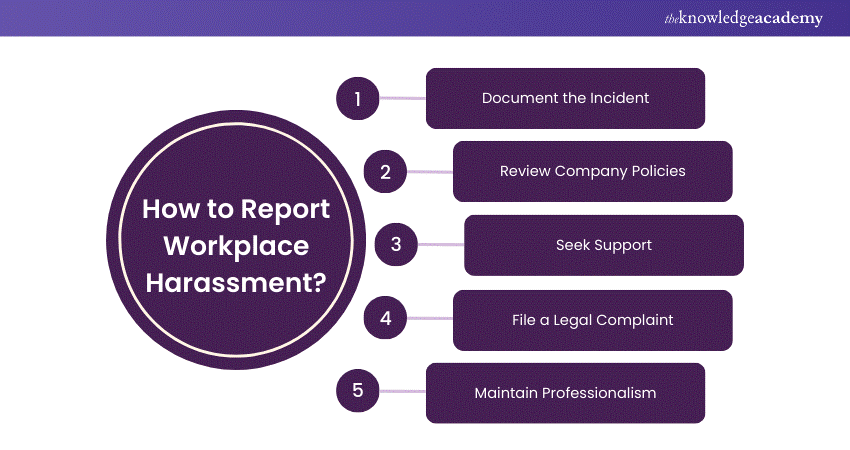We may not have the course you’re looking for. If you enquire or give us a call on +852 2592 5349 and speak to our training experts, we may still be able to help with your training requirements.
Training Outcomes Within Your Budget!
We ensure quality, budget-alignment, and timely delivery by our expert instructors.

Ever heard comments like, "You’re too old to keep up with this job", "Your work is pathetic”, "Women aren’t suited for leadership roles". Undoubtedly, these words are heartbreaking and are enough to scatter your dignity into pieces. Such remarks have been rooted down to Workplace Harassment for ages and need immediate attention to safeguard employees' well-being. This blog explains Workplace Harassment, its types and how you can protect your rights effectively.
Table of Contents
1) What is Workplace Harassment?
2) Types of Workplace Harassment
3) Examples of Workplace Harassment
4) Responsibilities of Workplace Harassment
5) How to Report Workplace Harassment?
6) Conclusion
What is Workplace Harassment?
Workplace Harassment is the most common issue that can take many forms such as mobbing, workplace aggression, and bullying. As per the latest report by Chartered Institute of Personnel and Development (CIPD) , every one in four employee faced Workplace Harassment in the past year.
The most pervasive types of harassment reported;
a) 48% of employees reported being humiliated
b) 35% faced conflicts or arguments
c) 34% experienced verbal abuse
d) Only 36% felt their conflicts were fully settled despite employer policies
This highlights a significant space between employer and Employee point of view, indicating a need for more sturdy measures to address and stop Workplace Harassment.
Types of Workplace Harassment
Workplace Harassment goes by various names, but here are some of the most experienced harassment types:

1) Psychological Harassment
Psychological harassment involves consistently targeting someone with the intention of lowering their self-worth and well-being. It includes behaviours such as verbal insult, shame, isolation, and continuous critique, which can weaken self-esteem and mental health.
This type of harassment commonly appears at work through subtle but regular negative interactions, resulting in a hostile environment. The consequences could be feelings of stress, worry, and reduced productivity.
Dealing with Psychological harassment requires having a strict policy that does not tolerate it, providing aid to impacted employees. Organisation should focus on creating an atmosphere where employees are valued and respected.
2) Physical Harassment
Physical harassment is the unwelcoming physical contact or intimidation leading to a hostile and unsafe surrounding. This may involve other actions like touching, pushing, improper physical contact, or indulging in someone's personal matters.
The goal is to establish dominance and authority over the target, typically resulting in feelings of fear, demeaning, and helplessness. Workplaces must have strict policies and training to prevent and address Physical harassment, keeping a safe and respectful atmosphere for all employees.
Systems for reporting and providing support need to be available to those impacted to encourage a zero-tolerance culture towards such behaviours.
3) Cyberbullying
Cyberbullying in the workplace is when digital tools are used to bully or intimidate coworkers. This may involve sending emails that are threatening or offensive, spreading harmful rumours via chat apps, or publicly embarrassing someone on social platforms.
The anonymous nature of Cyberbullying can have a serious impact on the employee's mental and professional well-being.
Establishing a respectful culture and robust Cyberbullying policies are crucial in safeguarding employees. Organisations should keep the conversation open with employees to understand the inner workings of their workplace.
Empower your IT business expertise with our BCS Practitioner Certificate In Being An IT Business Partner Training – Register now!
4) Verbal Harassment
Verbal harassment means using inappropriate words to insult or belittle someone. This also includes shouting, name-calling, making improper jokes, and using demeaning language.
Often ignored due to its non-physical nature, Verbal harassment can have serious psychological effects like Stress, anxiety, and a decline in job performance. It's mandatory for organisations to address Verbal harassment through transparent policies and training.
Empowering employees to report such behaviour and presenting support can help maintain a respectful workplace where employees feel safe and valued.
5) Discrimination
Unfair behaviour in the workplace based on factors like race, gender, age, religion, or disability is known as discrimination. This can be shown through biased hiring practices, unequal compensation, limited chances for advancement, or harassment. It makes the workplace environment toxic and results in reduced employee motivation, efficiency, and legal consequences for employers.
To address discrimination, companies need to establish specific guidelines, promote diversity, and offer equality training. Encouraging a workplace that is respectful enhances fairness, increases employee happiness, and nurtures a positive company environment.
6) Sexual Harassment
Sexual harassment includes non-consensual sexual advances, asking for favours, and other actions of a sexual nature. This kind of conduct may lead to a hostile work environment, impacting both employees' performance and mental health.
Examples consist of improper physical contact, suggestive remarks, and exchanging explicit content. Organisations need to implement strict policies and provide training to prevent and address this problem.
It is essential to have secure and confidential reporting systems in place for victims to maintain a safe workplace.
Responsibilities of Workplace Harassment
Workers should create a work environment that is ethical, professional, and productive by being aware of how their actions affect others.
Employees should:
a) Understand the factors that lead to Workplace Harassment
b) Refrain from participating in or supporting acts of harassment
c) Report any cases of harassment
d) Stick to office guidelines
Supervisors/managers should:
a) Have a good understanding of relevant policies
b) Show and maintain professionalism
c) Monitor for any harassment and promptly deal with them
d) Encourage protocols and instruct workers on suitable conduct
e) Establish clear expectations and address complaints instantly and fairly
f) Handle all allegations with care and attentiveness
The Department of Health will:
a) Create appropriate behaviour standards
b) Offer leadership and resources for initiatives against Workplace Harassment types
c) Ensure compliance with legal duties
d) Incorporate anti-harassment principles
Master organisational behavior essentials with our BCS Foundation Certificate In Organisational Behaviour – Join now!
How to Report Workplace Harassment?
Each company has an HR department to help employees during serious situations, ensuring their well-being and employment stability. Good HR practices are crucial when employees experience discomfort, danger, or feeling threatened by a coworker.
Although numerous organisations possess strong anti-harassment policies, smaller organisations may lack them. Here’s how one can report Workplace Harassment:

a) Document the Incident: Retain a detailed record of the harassment along with date, time, location and witnesses.
b) Review Company Policies: Educate yourself about the organisation’s harassment procedures and policies.
c) Seek Support: Consult a workplace advocate or trustworthy coworker to gain emotional support
d) File a Legal Complaint: File a complaint to the HR department
e) Maintain Professionalism: Maintain professionalism throughout the reporting process
Conclusion
Workplace Harassment is a usual issue that require immediate attention. From sexual misbehaviour to psychological abuse, it can take up many forms. If you experience such inappropriate misconduct or action in workspace, don’t hesitate to file a report to the Human Resource department. This protects your mental health and dignity, paving a more supportive and efficient workplace environment for other employees.
Strengthen your workplace values with our Ethics In Workplace Training today!
Frequently Asked Questions

Bullying, exclusion, menacing, passing inappropriate comments, unwanted touching, or verbal abuse are key signs of Workplace Harassment.

Reach HR department and report the incident and provide relevant evidence. The organisation will go through the matter and take actions based on their anti-harassment policies.

The Knowledge Academy takes global learning to new heights, offering over 30,000 online courses across 490+ locations in 220 countries. This expansive reach ensures accessibility and convenience for learners worldwide.
Alongside our diverse Online Course Catalogue, encompassing 19 major categories, we go the extra mile by providing a plethora of free educational Online Resources like News updates, Blogs, videos, webinars, and interview questions. Tailoring learning experiences further, professionals can maximise value with customisable Course Bundles of TKA.

The Knowledge Academy’s Knowledge Pass, a prepaid voucher, adds another layer of flexibility, allowing course bookings over a 12-month period. Join us on a journey where education knows no bounds.

The Knowledge Academy offers various Business Analysis Courses, including the BCS Certificate In Business Analysis Practice, BCS Practitioner Certificate In Being An IT Business Partner Training, and BCS Foundation Certificate In Organisational Behaviour. These courses cater to different skill levels, providing comprehensive insights into Factors Affecting Organisational Behaviour.
Our Business Analysis Blogs cover a range of topics related to Ethics, offering valuable resources, best practices, and industry insights. Whether you are a beginner or looking to advance your Business Analysis skills, The Knowledge Academy's diverse courses and informative blogs have got you covered.
Upcoming Business Analysis Resources Batches & Dates
Date
 BCS Practitioner Certificate in Being an IT Business Partner Training
BCS Practitioner Certificate in Being an IT Business Partner Training







 Top Rated Course
Top Rated Course



 If you wish to make any changes to your course, please
If you wish to make any changes to your course, please


